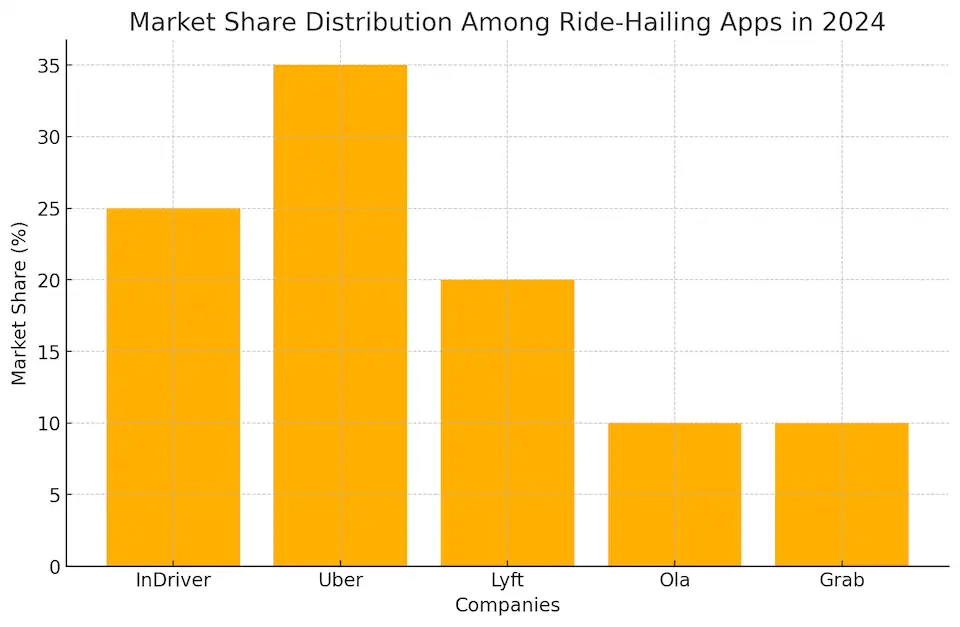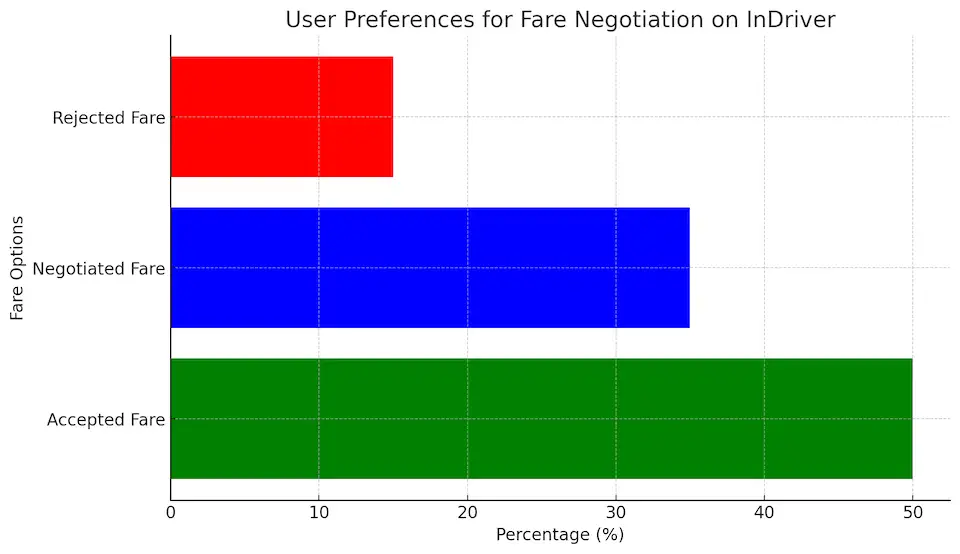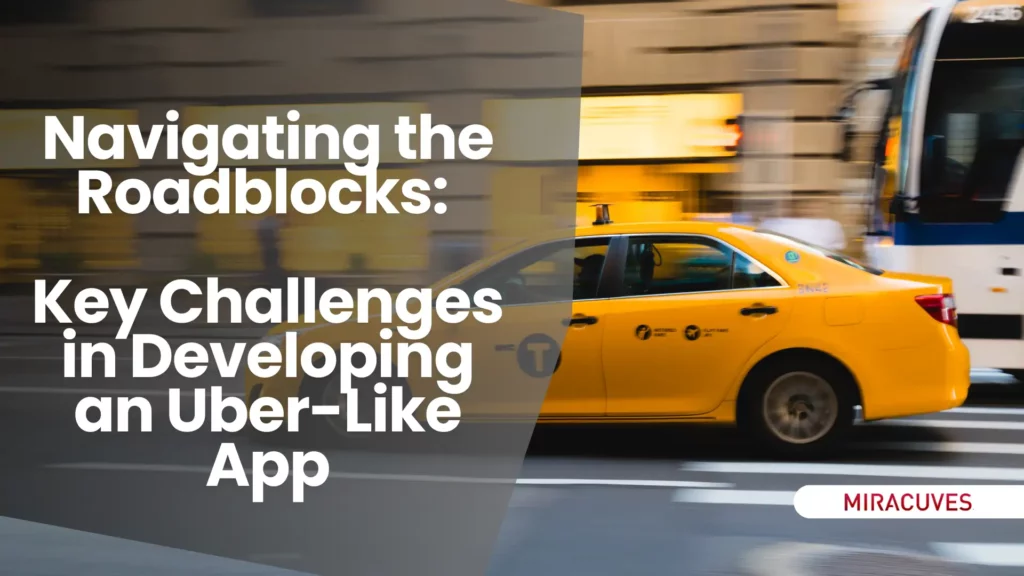InDriver, one of the most innovative players in the ride-hailing market, offers a unique business model that sets it apart from competitors like Uber and Lyft. Known for its fare negotiation feature, InDriver empowers users by allowing them to set their own ride prices, which drivers can either accept or counter. This approach has not only increased user engagement but has also made it a popular choice in many markets worldwide. Businesses inspired by this model can explore building platforms similar to an InDrive clone, enabling them to offer a flexible and user-driven experience. In this blog, we’ll explore how the InDriver business model operates, its revenue strategies, and why it continues to thrive in 2024.
The dynamic nature of InDriver’s model offers flexibility and cost transparency to users, providing a competitive edge in a rapidly evolving industry. By understanding the mechanics of its operations and the ways it generates revenue, businesses and developers can gain valuable insights into replicating or innovating within the ride-hailing sector.
This comprehensive guide will explore each aspect of InDriver’s operations, highlighting the strategies that make it successful and offering a deep dive into its technology, market positioning, and future growth plans.
What is InDriver?
InDriver is an on-demand taxi service app that operates with a unique approach: fare negotiation. Unlike traditional ride-hailing platforms like Uber or Lyft, where prices are algorithmically determined, InDriver allows passengers to set their desired fare when requesting a ride. Drivers in the vicinity then have the option to accept the proposed fare or counter it, fostering a transparent and competitive pricing model.
This dynamic pricing mechanism empowers both drivers and passengers, offering flexibility and promoting user satisfaction. For passengers, it ensures affordable and fair rates, while drivers benefit from the freedom to choose fares that align with their preferences and needs.
Key Differentiators of InDriver:
- Fare Negotiation: The app allows users to set and negotiate prices, unlike the fixed-pricing models of competitors.
- User-Centric Approach: InDriver focuses on giving control to its users, fostering a sense of empowerment and trust.
- Local Adaptation: InDriver tailors its services to fit the dynamics of local markets, making it a versatile solution in different regions.
This unique business model has helped InDriver gain traction across various markets, positioning it as a strong competitor in the ride-hailing industry, especially in emerging economies where price sensitivity and local adaptation are crucial.
Market Analysis for Ride-Hailing Apps in 2024
The global ride-hailing market continues to expand rapidly in 2024, driven by urbanization, technological advances, and the increasing preference for convenient, on-demand transportation services. InDriver, with its fare negotiation model, stands out as a versatile player capable of thriving in diverse markets, particularly in developing regions and emerging economies where price sensitivity is high.
| Market Trend | Description | Impact on InDriver |
|---|---|---|
| Urbanization | Increased urban population fueling ride demand | Expanding service reach |
| Regulatory Changes | Stricter laws on safety and driver welfare | Adapting services to comply |
| Sustainability Focus | Growing demand for eco-friendly transport options | Partnering with EV providers |
| Technology Integration | AI and real-time tracking becoming standard | Enhanced route optimization |
Key Market Trends in 2024:
- Increased Urbanization: The growing urban population globally fuels the demand for efficient, affordable transportation solutions like InDriver.
- Focus on Sustainability: Many ride-hailing platforms are integrating electric vehicles (EVs) and eco-friendly practices. InDriver’s flexibility allows it to adapt and integrate such models as needed.
- Regulatory Evolution: Governments worldwide are implementing stricter regulations on ride-hailing services, focusing on driver welfare, passenger safety, and environmental impact. InDriver’s adaptable approach positions it well to navigate these regulatory landscapes.

According to recent reports on ride-hailing industry trends, urbanization and regulatory changes are shaping the future of platforms like InDriver.
Competitive Landscape: InDriver competes with established giants like Uber, Lyft, and regional leaders such as Grab in Southeast Asia and Ola in India. Its dynamic pricing and localized approach provide a significant competitive edge, enabling it to grow in markets where other ride-hailing services may struggle due to rigid pricing models.
By understanding these market dynamics, InDriver is well-positioned to adapt its business model and expand its footprint globally, targeting regions with untapped growth potential while maintaining its competitive advantage.
How InDriver Works: A Step-by-Step Breakdown
InDriver’s operational model is built around its unique fare negotiation system, providing users with an interactive and flexible ride-booking experience. Here’s how the process works:
- Request a Ride: Passengers enter their pickup and drop-off locations, then set the price they are willing to pay for the ride. This price is based on their estimation of a fair fare.
- Driver Response: Nearby drivers receive the passenger’s request, including the proposed fare. They have three options:
- Accept the Fare: Drivers who agree with the proposed amount can immediately accept the ride.
- Counter the Offer: Drivers may negotiate by proposing a higher fare based on traffic conditions, distance, or other factors.
- Ignore the Request: Drivers can simply pass if the fare does not align with their expectations.
- Finalizing the Ride: The passenger reviews the drivers’ responses and chooses the driver that best suits their needs, considering factors like fare, driver rating, and estimated time of arrival.
- Completing the Journey: The driver picks up the passenger and completes the ride, after which both parties can rate the experience, contributing to the platform’s quality control and service improvement efforts.
Advantages of the InDriver Approach:
- Flexibility: Passengers and drivers engage directly, allowing for a fair and mutually agreed-upon price.
- User Empowerment: Passengers have more control over ride costs, while drivers have the opportunity to negotiate fares that match their expectations.
- Real-Time Adaptation: By adapting fares dynamically, the app ensures competitiveness even during peak hours, making it a practical alternative to other ride-hailing platforms with fixed pricing models.
This user-centric and flexible approach not only sets InDriver apart but also drives its rapid growth in diverse markets, particularly in regions where affordability and transparency are crucial.
Technological Infrastructure Behind InDriver
InDriver’s success is not just rooted in its innovative business model but also in its robust technological infrastructure. The platform relies on a scalable and adaptable tech stack designed to provide real-time, efficient, and secure services for both drivers and passengers. Below is an overview of the key components of InDriver’s technological setup:
- Cloud Infrastructure:
- InDriver uses cloud services (e.g., AWS, Microsoft Azure) to ensure the platform is scalable, reliable, and accessible globally. This helps manage the massive data generated by ride requests, tracking, and transactions.
- Real-Time GPS Tracking and Mapping:
- The app integrates advanced GPS tracking technologies, such as Google Maps API, to provide real-time tracking, route optimization, and accurate ETAs for both drivers and passengers.
- Payment Gateway Integration:
- InDriver supports multiple payment methods, including credit/debit cards, digital wallets, and cash, by integrating with secure payment gateways like Stripe or PayPal, ensuring safe and fast transactions.
- Database Management Systems:
- A high-performance database (e.g., MongoDB or PostgreSQL) is used to manage user data, transaction histories, driver records, and ride logs efficiently. This ensures that data is securely stored and easily retrievable.
- AI and Machine Learning Algorithms:
- InDriver incorporates AI algorithms to match drivers and passengers efficiently, optimize routes, and provide personalized ride suggestions based on historical data and user preferences.
- Machine learning models help analyze and predict peak hours, allowing dynamic pricing adjustments to optimize driver earnings and passenger costs.
- Security Protocols:
- The app uses encryption protocols (e.g., SSL/TLS) to protect sensitive user data, ensuring that all transactions and communications within the app are secure.
- Scalability and Load Balancing:
- InDriver’s platform is designed to handle high traffic volumes, employing load balancers and auto-scaling mechanisms that manage peak loads and ensure uninterrupted service.
To build a reliable and scalable ride-hailing platform like InDriver, it’s essential to implement best practices in app development and infrastructure management.
By leveraging these technologies, InDriver ensures a seamless, secure, and efficient ride-hailing experience for its users. This technological setup not only supports its unique business model but also enables the app to expand rapidly and adapt to various regional needs and requirements.
InDriver Business Model: Key Elements
InDriver’s business model is built on flexibility, transparency, and user empowerment, setting it apart in the competitive ride-hailing market. Here’s an in-depth look at its core components:
- Fare Negotiation System:
- InDriver empowers users by allowing them to set their own ride prices. Drivers can then choose to accept, negotiate, or ignore the fare. This model creates a dynamic, user-driven pricing environment, ensuring that passengers get competitive rates while drivers have more control over their earnings.
- Low Commission Rates:
- Unlike traditional ride-hailing platforms that charge high commissions (often up to 25-30%), InDriver charges a significantly lower commission. This approach attracts more drivers to the platform, ensuring availability and maintaining service quality.
- Localized Operations:
- InDriver adapts its services and pricing models to fit local markets, making it appealing in diverse regions. The app takes into account local regulations, economic conditions, and cultural preferences, providing flexibility for both drivers and passengers.
- Focus on Emerging Markets:
- By targeting emerging markets where competition is less intense and price sensitivity is high, InDriver secures a foothold in regions that are often underserved by other ride-hailing giants.
- Driver Incentives and Rewards:
- InDriver motivates drivers by offering incentives such as lower commission periods, referral bonuses, and loyalty rewards. This ensures driver retention and boosts satisfaction levels.
This business model focuses on building a user-driven ecosystem that emphasizes affordability, transparency, and local adaptation. By prioritizing flexibility and minimizing costs for drivers, InDriver continues to expand its presence and maintain a strong competitive edge in 2024.
InDriver Revenue Model: How Does InDriver Make Money?
InDriver employs a multi-faceted revenue model designed to maintain profitability while ensuring affordability for users and drivers. Here’s how the platform generates revenue:
- Commission-Based Earnings:
- InDriver charges a small commission on each ride, typically lower than its competitors, to incentivize more drivers to join and remain active on the platform. This strategy encourages higher driver retention and ensures more ride availability.
- Premium Features and Priority Booking:
- InDriver offers optional premium features like priority ride booking for users who prefer faster service during peak hours. This additional revenue stream provides users with flexibility while allowing the company to monetize urgent demand.
- Advertising and Partnerships:
- InDriver collaborates with local businesses and advertisers, integrating in-app ads and promotions. Partnerships with service providers such as insurance companies or vehicle maintenance shops also help generate revenue while enhancing value for drivers.
- Subscription-Based Model for Drivers:
- In some markets, InDriver offers a subscription model where drivers pay a flat fee for a certain period, allowing them to keep 100% of their ride earnings without per-ride commissions. This model is beneficial for high-earning drivers who prefer fixed costs.
- Dynamic Pricing Benefits:
- The platform also benefits from dynamic pricing during peak hours, where fares are slightly higher. While passengers still set prices, drivers may counter with higher fares that reflect increased demand, ensuring higher earnings for the company.
| Revenue Stream | Description | Example |
|---|---|---|
| Commission on Rides | Low commission fee per ride | 5-10% per ride |
| Premium Features | Optional add-ons like priority booking | Faster pickups during peak hours |
| Advertising & Partnerships | In-app ads and local business partnerships | Collaborations with insurance firms |
| Subscription Model | Flat fee option for drivers in certain regions | Monthly subscription for no per-ride fee |
By diversifying its revenue streams and keeping commissions low, InDriver creates a sustainable and scalable business model that aligns with its core philosophy of flexibility and user empowerment. This approach not only attracts more users but also ensures profitability in various markets globally.

Key Features of InDriver App in 2024
InDriver’s features are tailored to provide both passengers and drivers with an efficient, flexible, and user-friendly experience. Below are the key features that distinguish InDriver in 2024:
- Fare Negotiation System:
- The core feature where passengers set their own ride prices, and drivers have the option to accept, reject, or counter. This creates a competitive environment, benefiting both parties.
- Real-Time Tracking and Navigation:
- Integration with advanced GPS technologies ensures accurate route planning, real-time tracking, and precise ETAs, enhancing the user experience.
- Multiple Payment Options:
- InDriver supports diverse payment methods, including digital wallets, cards, and cash, ensuring convenience for users in various regions.
- Driver Incentives and Rewards:
- Programs designed to boost driver loyalty, such as lower commission rates, referral bonuses, and performance rewards, help maintain a robust driver network.
- Ride Filters for Passengers:
- Passengers can filter drivers based on criteria like ratings, vehicle type, and estimated arrival time, adding flexibility and control over ride preferences.
These features make InDriver adaptable, ensuring it remains competitive and user-friendly, catering to the evolving demands of the ride-hailing market.
InDriver User Experience: Benefits for Drivers and Passengers

InDriver’s user experience is crafted to prioritize flexibility, transparency, and user control, benefiting both drivers and passengers. Here’s how:
- Passenger Benefits:
- Cost Control: Passengers can set their preferred fare, ensuring they get the best price for their ride.
- Choice and Flexibility: Passengers have the option to choose drivers based on rating, vehicle type, and estimated time of arrival (ETA), offering a personalized experience.
- Driver Benefits:
- Earning Flexibility: Drivers can negotiate fares, allowing them to select rides that match their financial goals or situational demands (e.g., traffic conditions).
- Incentive Programs: Reward systems for loyal drivers, such as lower commission rates and bonuses, encourage driver retention and satisfaction.
- Safety Measures and Rating System:
- InDriver integrates safety features like real-time tracking and a two-way rating system, promoting accountability and trust between drivers and passengers.
| Benefit Category | Passengers | Drivers |
|---|---|---|
| Pricing Flexibility | Set your own fare | Negotiate fares that match your expectations |
| Ride Customization | Filter options for drivers and vehicles | Choose rides based on proposed fares |
| Incentive Programs | N/A | Referral bonuses, rewards, and lower commissions |
By focusing on these features, InDriver enhances the overall user experience, offering both parties more control and satisfaction, which helps maintain a loyal user base and differentiates the platform from traditional ride-hailing services.
Regulatory Challenges and Compliance
As InDriver expands globally, it faces various regulatory challenges that impact its operations. The ride-hailing industry is highly regulated, with governments implementing laws around passenger safety, driver welfare, and environmental standards. Here’s how InDriver addresses these issues:
- Local Compliance Adaptation:
- InDriver customizes its platform to comply with local regulations, including driver licensing, insurance requirements, and vehicle standards, ensuring its services remain legally compliant.
- Driver Welfare Programs:
- InDriver offers driver incentives and supports fair wages, aligning with regulatory mandates aimed at improving driver conditions.
- Passenger Safety Protocols:
- The app incorporates safety features like real-time tracking, SOS buttons, and driver verification processes to meet legal safety requirements.
By proactively adapting its model to align with regulatory environments, InDriver not only ensures compliance but also builds trust and reliability among its users, positioning itself as a sustainable and adaptable global player in the ride-hailing market.
InDriver vs. Traditional Ride-Hailing Platforms
| Feature | InDriver | Traditional Platforms (e.g., Uber/Lyft) |
|---|---|---|
| Pricing Model | Negotiable by users and drivers | Fixed algorithm-based pricing |
| Commission Rates | Low commission | High commission (up to 25-30%) |
| Flexibility for Drivers | High (choose rides and negotiate fares) | Limited control over ride acceptance |
| Localization | Adapts to local market needs | Generally uniform across markets |
| Expansion Focus | Emerging markets | Major cities and developed regions |
InDriver stands out from traditional ride-hailing platforms like Uber and Lyft due to its dynamic pricing and user-centered approach. Below is a comparative analysis highlighting the differences:
- Pricing Model:
- InDriver: Passengers set their own prices, which drivers can accept or counter, allowing for flexible and competitive fares.
- Traditional Platforms: Prices are algorithmically determined, often leading to surge pricing during peak hours without user input.
- Driver Engagement:
- InDriver gives drivers the freedom to choose rides based on negotiated prices, unlike other platforms where drivers have limited say over fare rates.
- Regional Adaptation:
- InDriver’s localized model allows it to operate effectively in diverse markets, adapting its offerings to align with regional economic conditions and regulations.
- Commission Structure:
- InDriver charges lower commissions compared to other platforms, making it more attractive for drivers, which helps maintain a strong driver network and enhances service availability.
This flexibility and focus on user empowerment provide InDriver with a competitive edge, especially in regions where affordability and local adaptation are critical for ride-hailing services.
User Acquisition and Retention Strategies
InDriver’s growth and success depend significantly on its ability to attract and retain users—both passengers and drivers. The platform employs several effective strategies that leverage its unique business model while integrating proven marketing and customer loyalty techniques. Below are the key strategies InDriver uses to acquire and retain its users:
1. Referral Programs
- InDriver offers attractive referral programs where both the referring user and the new user receive benefits such as ride credits or discounts. This incentivizes existing users to promote the app within their networks, fostering organic growth and expanding the user base rapidly.
- Example: A passenger who invites a friend to join InDriver receives a discount on their next ride, while the new user also gets a reduced fare on their first ride.
2. Targeted Marketing Campaigns
- InDriver uses data-driven marketing strategies to target users based on demographics, location, and behavior. By focusing on specific regions and user segments, InDriver can tailor its marketing messages and promotions to attract users who are most likely to benefit from its fare negotiation model.
- The platform also collaborates with local influencers and social media channels to boost visibility, especially in regions where word-of-mouth marketing is influential.
3. Loyalty and Incentive Programs for Drivers
- To retain drivers, InDriver offers loyalty programs that reward long-term and high-performing drivers with bonuses, reduced commission rates, and exclusive access to special features. This approach ensures that drivers remain engaged and motivated to provide high-quality service.
- Example: Drivers who complete a certain number of rides per week might receive reduced commissions for the following week, increasing their earnings potential.
4. Seasonal and Event-Based Promotions
- InDriver capitalizes on holidays, festivals, and special events by offering discounts and promotional rides. These seasonal campaigns not only attract new users but also keep existing users engaged by providing timely incentives that encourage app usage.
- For example, during peak travel seasons, InDriver might offer discounted rides or cashbacks, ensuring that users choose the app over competitors.
5. User-Centered Feedback Loop
- InDriver actively seeks feedback from its users through surveys, in-app ratings, and customer support channels. The platform uses this feedback to implement improvements and new features that align with user preferences, enhancing satisfaction and loyalty.
- By responding promptly to issues and incorporating user suggestions, InDriver builds trust and loyalty among its users, ensuring long-term retention.
6. Collaborations and Partnerships
- InDriver partners with local businesses and organizations, such as hotels, travel agencies, and event organizers, to offer ride discounts and exclusive deals to their customers. This not only enhances brand visibility but also brings in users who are already engaged in activities where transportation is a necessity.
- For example, partnering with a local event organizer could mean that users attending the event receive special ride discounts when using InDriver, further promoting the app’s usage.
By employing these comprehensive strategies, InDriver effectively acquires new users while retaining its existing base. This approach supports sustainable growth, especially in regions where competition is intense and user retention is critical for success.
Challenges Faced by InDriver and Mitigation Strategies
InDriver’s dynamic and innovative business model has allowed it to thrive in the competitive ride-hailing industry, but it still faces several challenges. Addressing these obstacles is crucial for maintaining its growth trajectory and ensuring long-term sustainability. Here’s an in-depth look at the challenges InDriver encounters and the strategies it employs to overcome them:
1. Regulatory Compliance and Legal Hurdles
- Challenge: InDriver operates in multiple regions, each with its own regulatory requirements for ride-hailing services. Regulations often include driver insurance, licensing, passenger safety, and data protection standards, which can vary significantly across countries and cities.
- Mitigation Strategy: InDriver adopts a localized approach to compliance by working closely with local authorities and legal experts. It customizes its services and implements safety measures like driver background checks, vehicle inspections, and user verification to align with regulatory demands. Additionally, the platform actively participates in dialogues with governments to shape policies that benefit both users and the ride-hailing industry as a whole.
2. Competition with Established Ride-Hailing Giants
- Challenge: Competing with global giants like Uber, Lyft, and regional leaders such as Grab and Ola is a significant challenge, especially in markets where these companies have already established strong brand recognition and customer loyalty.
- Mitigation Strategy: InDriver differentiates itself by offering a unique fare negotiation system that empowers users to control costs. To further build its brand, InDriver focuses on aggressive local marketing strategies, including partnerships with local influencers and businesses. It also offers lower commission rates for drivers and attractive referral bonuses, making it a more appealing option for both drivers and passengers.
3. Ensuring User and Driver Safety
- Challenge: Maintaining safety for both drivers and passengers is a critical aspect of ride-hailing services. Incidents related to security can damage a platform’s reputation and lead to user attrition.
- Mitigation Strategy: InDriver has implemented several safety features, such as real-time tracking, SOS emergency buttons, and two-way rating systems to enhance trust and accountability. Additionally, the company verifies driver backgrounds and conducts vehicle checks to ensure a safe environment. InDriver also offers 24/7 customer support to respond swiftly to any safety-related concerns.
4. Adapting to Dynamic Market Conditions and User Preferences
- Challenge: User preferences and market conditions are constantly evolving. As new technologies and services emerge, InDriver must adapt quickly to maintain its relevance and appeal.
- Mitigation Strategy: InDriver leverages data analytics and machine learning algorithms to study user behavior and trends. This data-driven approach allows the company to predict demand fluctuations, optimize routes, and adjust marketing strategies accordingly. By continuously iterating and introducing features based on user feedback, InDriver ensures that it remains user-centric and adaptable to market changes.
5. Managing Operational Costs and Scalability
- Challenge: Expanding into new regions and maintaining operational efficiency while keeping costs low is a significant challenge for InDriver, especially in markets with economic or logistical barriers.
- Mitigation Strategy: InDriver utilizes cloud computing services like AWS and Microsoft Azure to scale its infrastructure efficiently, reducing the need for heavy capital investment in physical resources. By leveraging advanced algorithms for route optimization and real-time tracking, InDriver reduces fuel consumption and improves overall ride efficiency, helping to keep operational costs manageable.
6. Building Brand Awareness in New Markets
- Challenge: Entering new markets requires building brand awareness and trust, which can be difficult in regions where users are loyal to existing ride-hailing services.
- Mitigation Strategy: InDriver implements aggressive localization strategies, customizing marketing campaigns and features to fit the specific needs and preferences of new markets. It also partners with local influencers, event organizers, and businesses to promote the brand organically. Offering promotional discounts and referral programs in these regions further helps accelerate user acquisition and brand recognition.
By proactively addressing these challenges with well-planned strategies, InDriver strengthens its position in the competitive ride-hailing market. This adaptive and localized approach ensures its continued growth and success, even in the face of industry obstacles.
Case Study: Successful Expansion of InDriver in a New Market
To illustrate InDriver’s effective business model and strategies, we explore a case study of its successful expansion into the Latin American market. This example demonstrates how InDriver’s adaptability and localized approach have allowed it to penetrate a new region and grow rapidly.
Background
InDriver initially launched in Russia and saw substantial growth due to its innovative fare negotiation model. Building on this success, the company set its sights on Latin America, a region with high demand for affordable and flexible transportation services but dominated by existing ride-hailing giants like Uber and local competitors such as Cabify.
Challenges Faced
- Strong Competition: Competing against established brands like Uber and Cabify, which already had significant market share and brand loyalty.
- Regulatory Compliance: Adapting to various regulations in different Latin American countries, which have strict rules on driver licensing, passenger safety, and ride-hailing operations.
- Cultural Adaptation: Understanding local market dynamics and user preferences, including language barriers and specific regional needs.
Strategies Implemented
- Localized Marketing Campaigns:
- InDriver launched targeted campaigns focused on the unique benefits of its fare negotiation model, emphasizing how it offers users more control over ride costs compared to fixed pricing systems used by competitors.
- The company collaborated with local influencers and social media platforms popular in the region to reach a wider audience and establish credibility.
- Adapting Services to Local Regulations:
- InDriver worked closely with local legal experts and authorities to ensure compliance with regulations in each country it entered. This included implementing mandatory driver verification processes, background checks, and safety features like real-time tracking.
- The platform also adapted its payment options to align with the preferences of local users, incorporating popular regional digital wallets and allowing cash payments to accommodate users without bank accounts.
- Driver Incentives and Reduced Commissions:
- To attract drivers quickly, InDriver initially offered reduced commission rates in Latin America, making it a more profitable option for drivers compared to other platforms. This helped build a strong network of drivers, ensuring sufficient supply for the growing demand.
- InDriver also introduced a loyalty program for drivers who consistently provided high-quality service, further enhancing driver retention and satisfaction.
- Tailoring the App to Local Preferences:
- The app interface was translated and adapted to fit the local languages and cultural nuances of each country in the region. For example, InDriver added features that allowed passengers to choose drivers based on preferred vehicle types, a popular preference among Latin American users.
Results and Impact
- Rapid User Growth: Within the first year of launching in Latin America, InDriver registered over a million users, significantly increasing its market presence. The fare negotiation model resonated with local users, who valued the affordability and control it offered.
- Increased Driver Retention: By offering competitive commissions and loyalty programs, InDriver successfully built a large and active driver base, which helped maintain ride availability and minimize wait times for passengers.
- Brand Recognition: Through localized marketing efforts and collaborations with local businesses, InDriver quickly established its brand as a competitive alternative to Uber and Cabify, gaining traction in major cities like Mexico City, São Paulo, and Lima.
Lessons Learned
- Localization is Key: Adapting services, marketing, and operations to fit local preferences and regulations is crucial for success in new markets.
- Driver Engagement is Essential: Offering incentives and maintaining low commissions help build a strong, reliable network of drivers, ensuring service quality and availability.
- Differentiation Drives Growth: By focusing on its unique fare negotiation model, InDriver effectively differentiated itself from competitors and attracted a user base looking for more flexibility and control.
This case study highlights how InDriver’s strategies and business model are adaptable to new regions, making it a scalable and resilient platform capable of expanding successfully in diverse markets worldwide.
Future of InDriver: Scaling and Expanding in 2024
InDriver has a strategic plan for scaling and expanding its operations in 2024, focusing on both existing and new markets. Below are the key elements of its future growth strategy:
- Market Penetration in Emerging Economies:
- InDriver aims to strengthen its presence in developing regions where traditional ride-hailing platforms face challenges due to pricing rigidity. By adapting its flexible fare negotiation model, it can attract a cost-sensitive customer base.
- Integration of Sustainable Practices:
- In response to increasing demand for eco-friendly transportation, InDriver plans to partner with electric vehicle (EV) providers and promote green rides. This not only aligns with global environmental regulations but also appeals to a growing eco-conscious user base.
- Technology Enhancements:
- InDriver will continue to invest in AI-driven route optimization and dynamic pricing algorithms to enhance user experience and operational efficiency, ensuring the platform remains competitive.
- Partnerships and Local Collaborations:
- To accelerate expansion, InDriver is forming partnerships with local businesses, such as vehicle leasing companies, maintenance service providers, and insurance firms. This localized approach helps InDriver integrate into new markets smoothly and build trust within local communities.
- Regulatory Alignment and Compliance Adaptation:
- InDriver is developing strategies to comply with new regulatory requirements worldwide, ensuring it maintains a legal and adaptable framework. This includes proactive engagement with local governments to align its services with evolving standards for ride-hailing platforms.
By focusing on these strategic growth areas, InDriver aims to expand its user base, strengthen its brand, and increase its market share globally, ensuring its position as a leading ride-hailing platform in 2024 and beyond.
Conclusion
InDriver’s unique business model, centered around fare negotiation and flexibility, sets it apart in the competitive ride-hailing industry. By understanding how InDriver empowers its users, adapts to local markets, and generates revenue through diverse streams, entrepreneurs and developers can gain valuable insights into creating or enhancing their own ride-hailing platforms.
In 2024, InDriver’s focus on dynamic pricing, user-centric features, and localized strategies continues to drive its expansion and success. With the right technological and regulatory adaptations, InDriver remains a model for innovation in the ride-hailing space.
Interested in developing a ride-hailing app like InDriver? Explore our app development services at Miracuves Solutions to start your journey today.
FAQs
1. How does the InDriver business model work?
The InDriver business model is based on fare negotiation, allowing passengers to set their own prices for rides. Drivers can accept, counter, or reject these offers, creating a dynamic pricing environment that benefits both parties. This model is unique in the ride-hailing industry, giving users more control over costs.
2. What is InDriver’s revenue model?
InDriver generates revenue through various streams, including commission fees on rides, premium features like priority bookings, in-app advertising, and driver subscriptions in select regions. This diversified revenue model helps InDriver maintain profitability while offering low-cost services.
3. How does InDriver differ from Uber and Lyft?
Unlike Uber and Lyft, which use algorithm-based pricing, InDriver allows passengers to negotiate fares directly with drivers. This unique approach offers flexibility, affordability, and greater control over ride costs, particularly appealing in price-sensitive markets.
4. Is InDriver safe to use for passengers and drivers?
Yes, InDriver incorporates multiple safety features such as real-time GPS tracking, SOS buttons, and a two-way rating system to enhance passenger and driver safety. The app also verifies drivers, ensuring a secure environment for its users.
5. What are the main features of the InDriver app in 2024?
Key features of the InDriver app include fare negotiation, multiple payment options (cash, digital wallets, and cards), driver incentives, and real-time tracking for both drivers and passengers. These features make it a flexible and user-friendly platform.
6. How does InDriver adapt to different markets and regulations?
InDriver customizes its services to comply with local regulations and market demands. By partnering with local businesses and integrating features like electric vehicle options, the platform ensures it meets the requirements of diverse regions while expanding its user base.































































